Walking around the Sala delle Udienze (Audience Hall ) of Perugia’s Nobile Collegio del Cambio , one will easily spot, on the wall toward the entrance, a self-portrait of the author of the frescoes, Perugino (Pietro Vannucci; Città della Pieve, c. 1450 - Fontignano, 1523), and immediately below his effigy, which realistically restores him to us as a somewhat weighed-down 50-year-old, one will find an inscription that reads: “Petrus Perusinus Egregius / Pictor / Perdita si fuerat pingendi / hic rettulit artem / Si nusquam inventa est / hactenus ipse dedit,” meaning “Peter Perugino egregious painter: if the art of painting was lost, he recovered it, and if it had never until then been invented, he created it.” At first glance this might appear to us to be less than a statement of modesty, in short, though we should not read it as an incensation of himself: the inscription in fact was most likely dictated by the humanist who devised the room’s iconographic program, Francesco Maturanazio (Perugia, 1443 - 1518), who drew from the classical and humanistic tradition (particularly Pliny and Petrarch) to elevate the artist to the status of divine painter, since in the classical tradition it was the prerogative of deities to teach the arts to mortals.
And indeed already in ancient times the frescoes in the Sala delle Udienze at the Collegio del Cambio were considered one of Perugino’s best works, if not his masterpiece. Even such a detractor of Perugino as Giorgio Vasari, in his Lives, expresses a very positive opinion of this cycle of paintings, recalling how many considered it his most important work: “This work, which was beautiful and praised more than any other that was worked by Pietro fusse in Perugia, is today by the men of that city, for the memory of so praised an artificer of their country, held in esteem.” Perugino was called to decorate the Sala delle Udienze in 1496. TheArte del Cambio was one of the main professional guilds in 15th-century Perugia: it was the association that protected the interests of moneychangers (banks, we would say in contemporary terms) and, along with theArte della Mercanzia, it was the only one that had received the privilege of being able to open its headquarters directly inside the Palazzo dei Priori, that is, the building that symbolized the city’s civic virtues, the seat of secular power, the place that was supposed to represent all Perugians. The premises of the Collegio del Cambio are located on the first floor of the Palazzo dei Priori, and the Audience Hall was the place where members of the guild met, received, and discussed their activities. The contract for Perugino’s commission, long unknown, was found in theState Archives of Perugia and published in 2013 in Burlington Magazine by Alberto Maria Sartore: signed in 1496, the document was crucial to clarify the chronology of the work and to get an account of the changes in progress, since at one point the program was modified. It is not the final agreement, but a preliminary draft drawn up in the vernacular by the Cambio’s notary, Pietro Paolo di ser Bartolomeo and bears the date May 11, 1496.
 The
The The Audience Hall of
The Audience Hall ofRepresenting the Cambio were two “auditors,” i.e., two senior officials, Amico Graziani and Mario Monaldi, who reported that they had had a preliminary meeting with Perugino to work out the details of the decoration (they were the ones who had proposed the name of the painter from Città della Pieve to the Cambio in January). The document begins by describing the elements of the vault, which was to be decorated with images of the seven planets accompanied by “animals” and other “ornaments.” Each of the planets was to be painted in gold or silver, while the “ornaments” were to be in “azzuro de la Magna,” or German azurite. The contract then describes the program for the four walls starting with the two lunettes on the southern wall, that is, the one opposite the monumental wooden “seat” intended for those who presided over the meetings. In these lunettes Perugino was called upon to paint the four cardinal virtues and, on the north wall, images of twelve illustrious figures of antiquity, but no further specifications were given. As for the western wall, the indications were more precise: a Nativity and a Transfiguration to be executed in oil on panel, with decorations in gold, ultramarine blue and various other precious pigments. To finish the work, the Cambio gave Perugino one year from the time the contract was signed: to be precise, six months for the ceiling and wall frescoes, and another six months for the parts in oil on panel. The sum agreed upon was 350 ducats: 50 immediately, 50 upon completion of the frescoes, 50 at the beginning of the works on panel, and finally 50 for each year until the full sum was reached (payments, under this system, would continue until 1507). In short, it was a contract “particularly disadvantageous for the painter,” as Sartore wrote. “Not only was he obliged to complete the entire program within the year (an unrealistic time frame, given the size and complexity of the cycle, without calculating the other commitments signed by Perugino), but 200 of the 350 ducats promised were paid in fixed annual installments of 50 ducats spread over four years only after the frescoes were finished.” Moreover, the artist evidently incurred some penalties since he delayed the delivery of the cycle, and since the signing of the contract the payments lasted for almost ten years.
The Arte del Cambio intended to avail itself of the services of one of the most important artists around at the time, at the height of his career, moreover at a time when he had just returned to Perugia from Florence and was overburdened with commitments: at the same time, for example, he was awaiting the realization of the Madonna of the Confraternity of Consolation, the Polyptych of St. Peter, the Banner of Justice and other works that punctuated the era of his success. The artist, for his part, was, however, quite happy to remain in the city, so much so that in 1496 he commissioned one of his trusted men to manage his affairs in Florence: Perugino was thus able to organize the work in the best possible way, which could obviously count on the extensive collaboration of the workshop. There is, moreover, a document from 1496 attesting to the renting of a room, a few steps from the Collegio del Cambio, by a group of artists consisting of Ludovico d’Angelo, Sinibaldo Ibi, Berto di Giovanni, Lattanzio di Giovanni and Eusebio da San Giorgio: before the discovery of the contract for the Sala delle Udienze there had been talk of a “society of 1496” founded almost to compete with Perugino, while since the discovery Sartore has speculated that in reality it must not have been a sodality that intended to compete with the master, but perhaps it was a “team of assistants that the master needed to realize such an ambitious cycle.” A cycle that, as anticipated, underwent changes during the course of the work: the Nativity and the Transfiguration, for example, were eventually painted in fresco and not on panel. Perugino, however, did not begin work immediately: in fact, he spent much of 1497 between Florence and Fano, to devote himself intensively to the Cambio paintings beginning in 1498. The work was completed in 1500, as attested by the date left by the artist above one of the pillars.
As we have seen, the contract did not delve more deeply into the content of the cycle. In fact, more precise indications would have reached the painter from a commission charged with elaborating the iconographic theme: however, it is not known whether at the time the contract was signed the program was already clear, or whether it was still under discussion. It has long been known, however, that the refined iconographic program was due to Maturantius, who imagined a mixture of sacred and pagan themes, drawing inspiration from Cicero’s De officis and De inventione (of which the Perugian humanist possessed an incunabulum, now preserved at the Augusta Library in Perugia with inventory number 296, where annotations by Maturantius himself can be seen related precisely to the Cambio cycle). In particular, it is in the De inventione that the great Roman orator asserts that law is an expression of human reason that finds agreement with natural reason(ius naturale), and that political wisdom is based on the exercise of the virtues, defined by Cicero (in Book II, Chapter 159) as “a disposition of the mind according to nature and reason,” formed of four parts, which coincide with the Christian cardinal virtues: prudence, justice, fortitude and temperance. Other sources of inspiration for Maturantius were other ancient texts such as Valerius Maximus’ Factorum et dictorum memorabilium libri , but also modern works such as Johann Engel’sAstrolabium (Latinized as Johannes Angelus), published in 1494, or perhaps the latter’s direct source, Baccio Baldini’s astrological calendar, a rather popular publication at the time and printed in several editions, which the artist might have taken as a model for the depiction of the planets. Perugino, however, was not a mere executor: in fact, we can imagine him in dialogue with Maturantius on the choice of iconographic solutions (for example, the scholar Rudolf Hiller von Gaertringen attributes to him the invention of the combination of heroes with virtues and inscriptions, which probably arose from his confrontation with the humanist). The basic idea of the cycle, which was meant to provide a kind of example to anyone entering this room, as Pietro Scarpellini has written, is that in Christ “the cardinal virtues, exemplified by the famous men, are fully realized, especially the Justice that must regulate public activity in the Audience of the Exchange.” Therefore, the man who wishes to approach the example of Christ will have to follow the virtues of the illustrious ancients, and be guided by the Christian virtues, all of which are represented in the frescoes of the Audience Hall. The symbolic unity of the cycle is thus expressed in the solidity and harmony of the compositional layout, which “thus reveals a unitary conception, manifested in compact and coherent forms.”
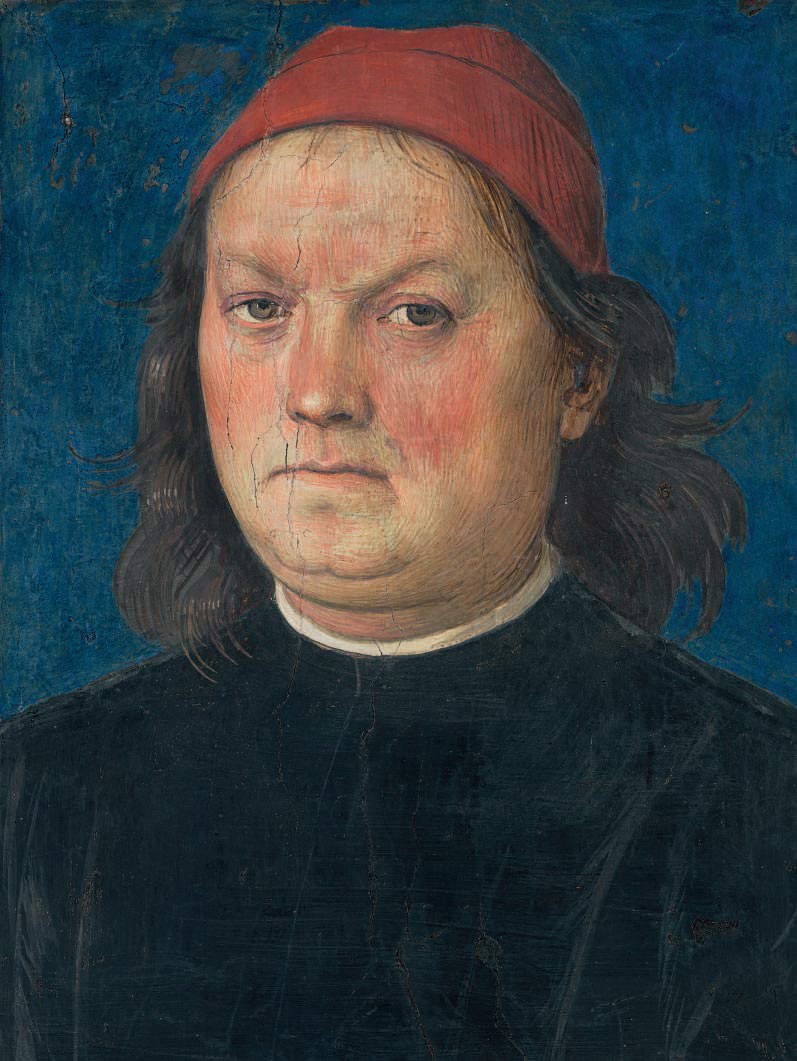


 Perugino
Perugino
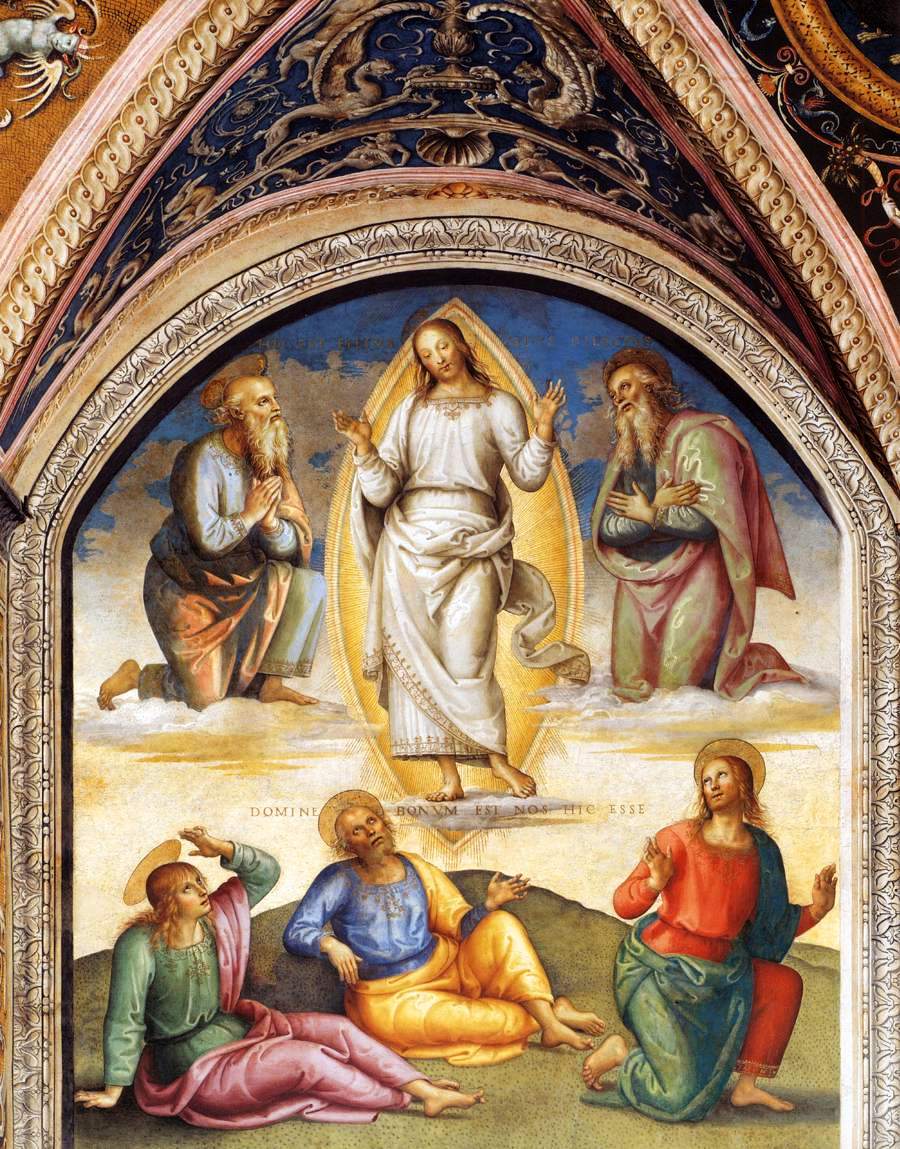
Presiding, so to speak, over the entire cycle is the figure of Cato Uticense, a symbol of freedom (due to the fact that he had preferred to kill himself rather than accept seeing the republic submit to Julius Caesar: this is the image of the Uticense that has also been handed down to us by Dante Alighieri’s Commedia ), a historical figure who was also appreciated by the cycle’s main supporter, Amico Graziani, who was, moreover, a friend of Maturantius. It is he who introduces the visitor to the reading of the cycle, which can begin on the walls with the sacred scenes: it starts with the Transfiguration, the episode described in the gospels of Matthew, Mark and Luke during which Jesus, after leading the disciples Peter, James and John with him to Mount Tabor, changed his appearance, showing himself together with the prophets Moses and Elijah in a supernatural light. Perugino paints Christ in a mandorla, with a tried-and-true scheme: he is in the center, the two prophets are beside him in a symmetrical position, kneeling on two clouds, while the lower register, occupying an exact half of the composition, houses the three disciples looking on in amazement, with John raising a hand to shield himself from the glare. Surrounding the figure of Christ are the inscriptions “Hic est filius meus dilectus” and “Domine bonum est nos hic esset,” or “This is my beloved son” and “Lord, for us it is good to be here” (this is the phrase Peter would have uttered after Jesus’ appearance tending to show them a glimpse of the beauty of paradise, as we read in Matthew’s gospel). The Transfiguration scene alludes, according to the interpretation of scholar Elvio Lunghi, to Faith, while Charity is represented by the Nativity: the characters (the Virgin, the Child Jesus and St. Joseph) are depicted under a classical architecture with tall columns, decorated with grotesque motifs, and here too they are arranged symmetrically, echoing the setting of the counterpart scene the artist had painted in the Sistine Chapel (later removed to make way for Michelangelo’s Last Judgment ). The Child is in the center, the parents are at his sides, kneeling, while the shepherds further back are placed to form a pyramid, with the one on the left being counterbalanced on the opposite side by the ox and donkey. Behind, the view opens onto the Umbrian landscape (we glimpse, in the distance, the ubiquitous Lake Trasimeno , which Perugino almost always included in his landscape views), where three angels appear, singing songs in praise of the newborn Christ, and, below on the left, we also observe a shepherd who is leading his flock. The adjacent wall sees a large lunette with the image of theEternal among angels above a group of prophets and sibyls, together symbolizing Hope, the third theological virtue. The figure of the Eternal Father appears in a gilded circle surrounded by all the angelic hierarchies (angels, cherubim, and seraphim), and below him, in another landscape with the hills of Umbria, are seen the characters identified by their cartouches: from left to right meet Isaiah, Moses, Daniel, David, Jeremiah, and Solomon for the group of prophets, and then the sibyls Erythraea, Persica, Cumana, Libica, Tiburtina, and Delphic. All these characters announce the coming of the son of God. A curiosity: it is the only one of the scenes whose design was brought back to the wall using the engraving technique and not the dusting technique.
The other two scenes are depicted on the opposite wall. Both follow the same pattern: there we find two of the four cardinal virtues seated in heaven, identified, in addition to their typical iconographic attributes, by the tables supported by pairs of putti, and below them six heroes of antiquity. On the left, Prudence and Justice (with their attributes: the mirror and the sword) are depicted above Fabius Maximus, Socrates, Numa Pompilius, Furius Camillus, Pittacus and Trajan, while on the right, Fortitude and Temperance (shield and staff the former, the two pitchers for “tempering” water the latter) appear above six other heroes, namely Lucius Siconius, Leonidas, Horatius Coclite, Publius Scipio, Pericles and Cincinnatus.
Prudence (prudentia) is for Cicero “the knowledge of good and bad things” and consists of three parts: memory, intelligence and foresight, embodied by Fabius Maximus, Socrates and Numa Pompilius, respectively. The inscription suggests not doing things one might regret, and rather seeking the truth. Justice(iustitia), on the other hand, is defined in the De inventione as a “habit of mind that protects the common good,” and results from ius naturae (natural law, i.e., that which does not descend from opinion, but from an innate instinct that is grounded in religio, pietas, gratia, vindicatio, observantia , and veritas: ius naturae is personified by Furius Camillus), by custom, which establishes useful things (Pittacus), and by written law (Trajan). The inscription states that if men like the three who impersonate the three qualities of justice were born into the world, there would be no more evil deeds. Fortitude (fortitudo) is according to Cicero “the ability to face danger and endure hardship.” Its parts are magnificentia (magnanimity, generosity), fidentia (security and self-confidence) patientia (patience) and perseverantia (perseverance). The magnificentia is represented by Lucius Siconius, fidentia by Leonidas, and patientia and perseverantia by Horace Coclite. In the inscription it can be read that those who practice fortitude have nothing to fear. Finally, temperance (temperantia) is in De inventione described as “the firm and moderate control of reason over lust and other improper impulses.” It is composed of continentia (continence), clementia (clemency) and modestia (modesty), values to which the characters of Scipio the Africanus, Pericles and Cincinnatus correspond. In the inscription, temperance is identified as a “goddess” who can teach self-control. According to the aforementioned Elvio Lunghi, the idea of interpreting the frescoes as allusions to the seven Christian virtues might look to the well-known precedent of the paintings that Sandro Botticelli and Piero del Pollaiolo executed between 1469 and 1470 for the Tribunale della Mercanzia in Florence, the institution that judged commercial offenses (we are thus moving into the sphere in which the Arte del Cambio of Perugia also operated), all of which are now preserved in the Uffizi. And it would be a fully compliant program, as Stefania Gialdroni has well summarized in her essay Perugino’s Justice. The Frescoes for the Collegio del Cambio between Legal History, Iconography, and Iconology of 2022, to Maturancius’s ideal of the christianus vir "who must pursue both cardinal and theological virtues, based on the assumption that Christianity has shown the world true justice and reconstructed human life on the two fundamental pillars of pietas andhumanitas.“ According to Gialdroni, the cycle conveys the Perugian bankers’ idea of justice in the 15th century: not so much punishing delinquents as ensuring that the law was enforced quickly and on the basis of mercantile custom and fairness. Indeed, the Statute of Cambio, approved in 1377, required that judgments be applied quickly, simply and without difficulty (”summarie, simpliciter et de plano“) and according to law, truth, equity and good custom (”de iure, veritate et equitate et secundum bonam consuetudinem“). The figure of Cato was thus functional in inviting the members of the College to ”leave behind personal passions in order to follow the right path. This,“ Gialdroni writes, ”is the message that the merchants wanted to give, this is the image of mercantile law and justice that they wanted to project: no violent scenes, no punishments, no references to the ’books of the law’ (i.e., the ius commune), but rather a kind of harmony, an invitation to moderation, or rather to ’temperance’."
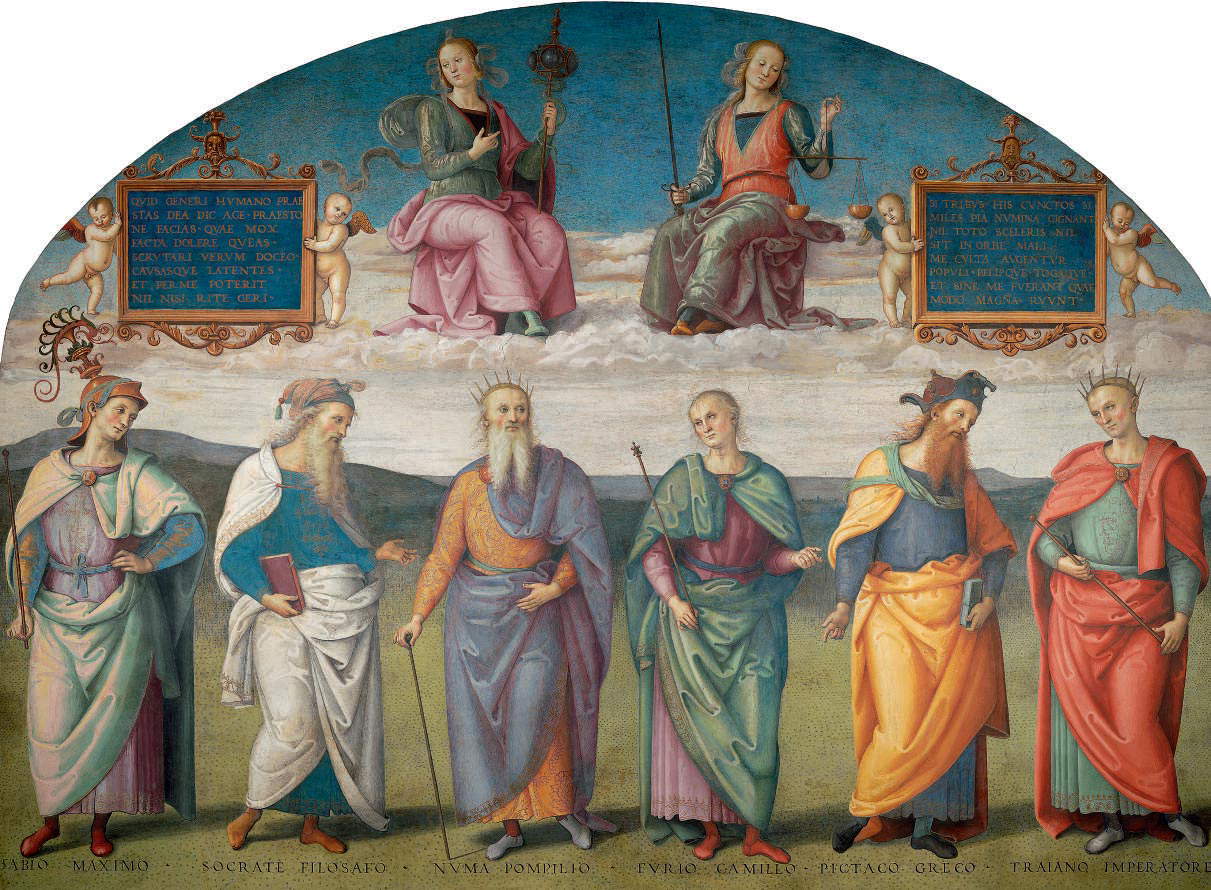
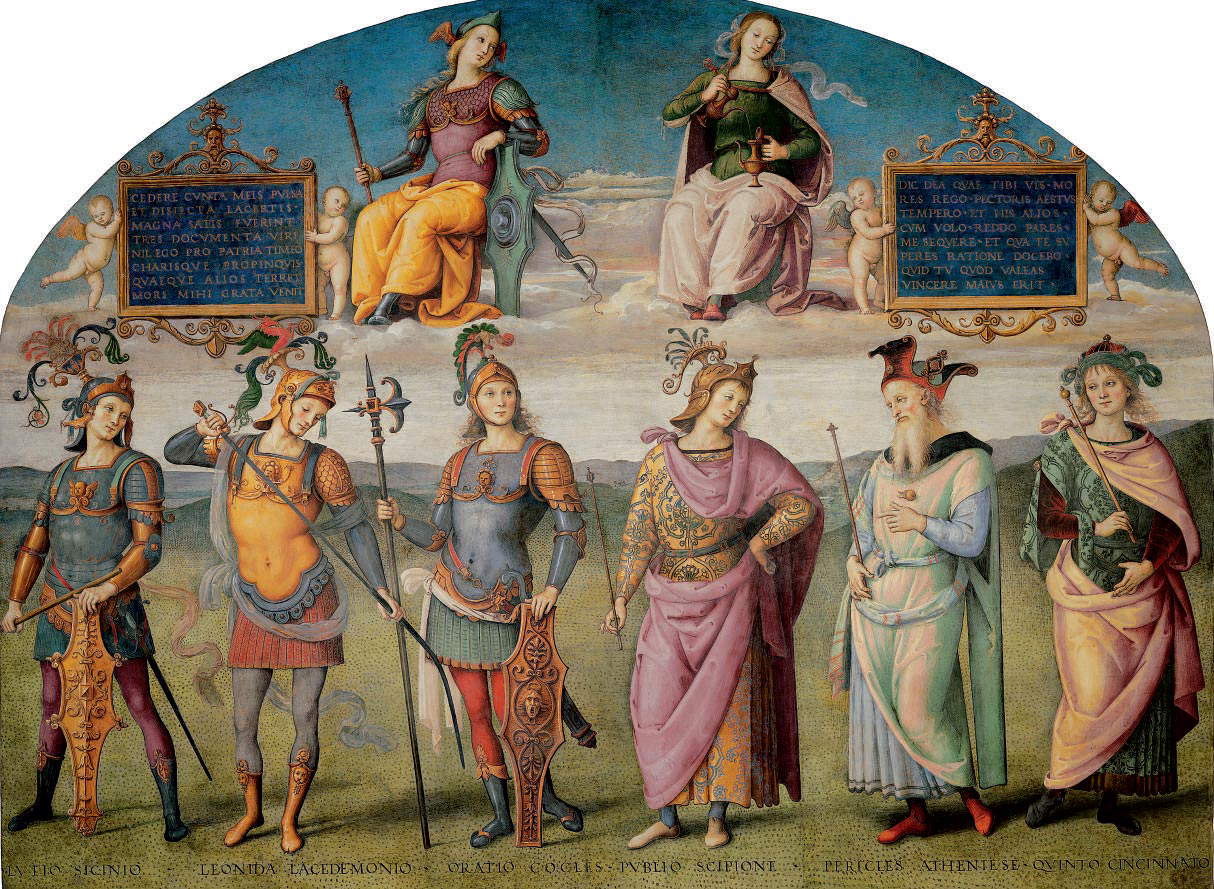
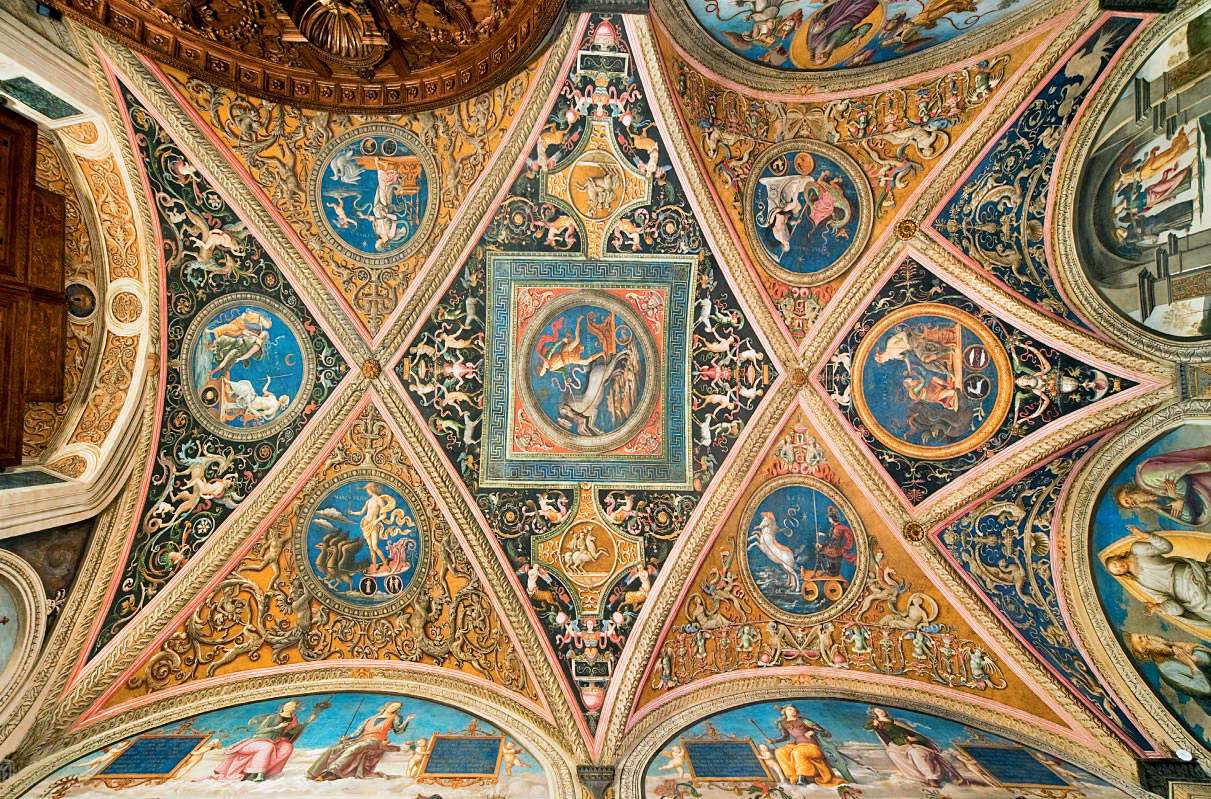
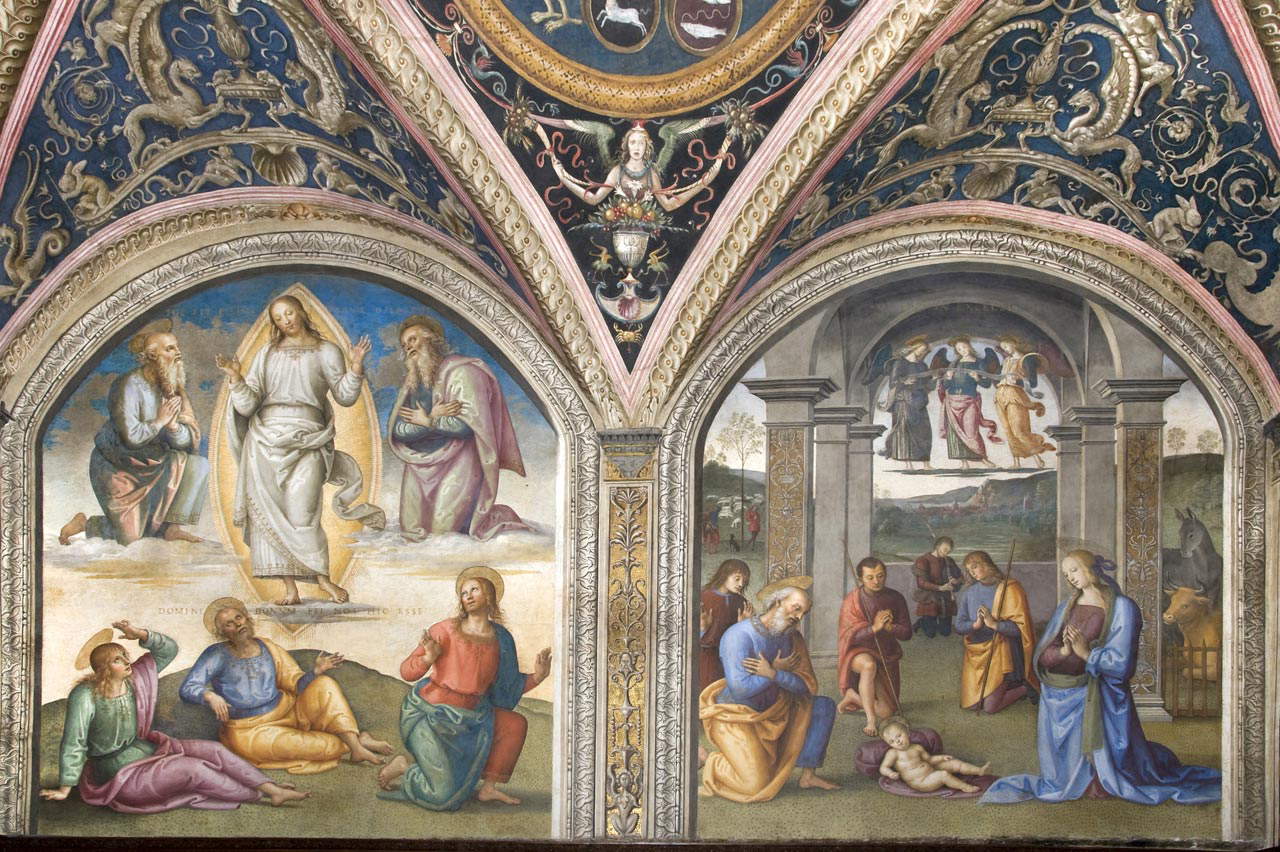
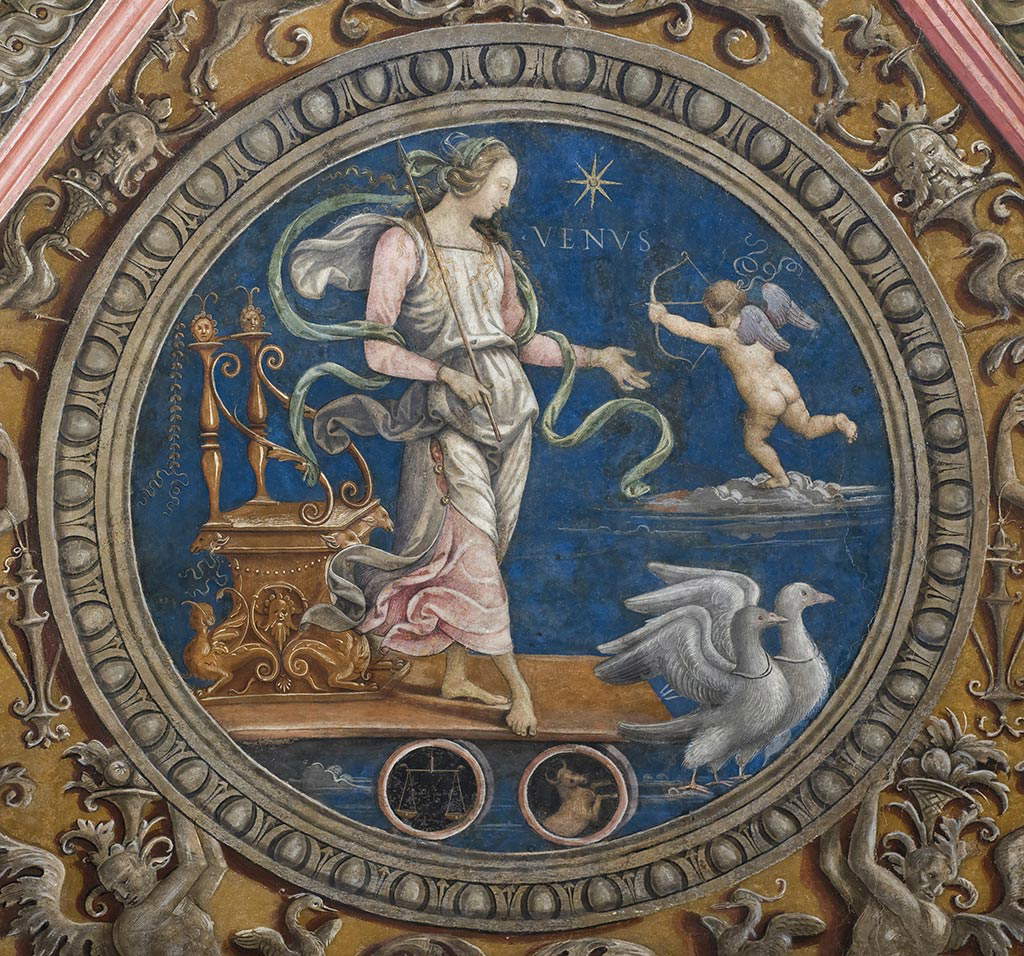
Finally, we turn our gaze upward to see depictions of the seven planets, whose influence, according to the beliefs of the time, could affect human activities. In the depiction of the planets, Hiller von Gaertringen, in his essay published in the catalog of the Perugino six-hundredth anniversary exhibition in 2023, speculated on the possible presence of Pinturicchio, who would have collaborated in the creation of these images (and in his opinion one could also discern thehelp from the young Raphael in the drawing of the scene with the prophets and the sibyls, which manifest more varied positions than Perugino’s usual ones, and denser grouping: no such marked variations from the master’s style are found in his usual collaborators). Here, then, is the Sun in the center (with the god Apollo, associated with this star), Saturn, Jupiter and Mars on the back wall, and Mercury, the Moon (with the goddess Diana) and Venus decorating instead the part above the window. The presiding deities of the planets are all depicted on chariots drawn by animals, as per widespread iconography. In the frames also unfolds all the inventiveness of the artist, who for the “other ornaments” indicated by the contract imagined real and fantastic animals, masks, plant motifs, which, however, were for the most part materially executed by his collaborators.
Perugino had finished his work taking longer than the time planned, but he succeeded in the feat of painting one of the most significant works of the Renaissance, one of the works that best embodies the humanistic idea of blending classical and Christian elements, and he was able to do so without offering particularly original contributions or disruptive novelties: on his side he had the ability to shape the most up-to-date thinking of his time with a calm, serene, elegant (detractors would also say “repetitive”) painting, as much in figures as in landscapes, that neither shocked nor disquieted his clientele but at the same time proved in line with modernity, thanks to his ability, Vittoria Garibaldi wrote, “to transpose literary, humanistic and classical concepts into figurative, harmonious and calm images made up of rhythmically alternating silences.” This is why a great scholar like Lionello Venturi defined Perugino, in his volume on the frescoes of the Collegio del Cambio, as “the most traditional among modern painters and the most modern among traditional painters.” Thus we return to where we started: to thepainter’s self-portrait. This is not the image of a full-figured artist celebrating himself in a work he executed. In the meantime, Perugino, as Laura Teza has observed, becomes a symbol of the redemption of an entire city, a role essentially unheard of for an artist, at least in Perugia. Maturantius, in one of his Oratio in qua laudes et origo Perusiae tractantur, presented Perugino “as a celebrated example of the intellectual and practical virtues of the Perugian homeland,” Teza writes, "a possible exemplum for the dormant wits of the city, which does not fully experience its great intellectual season because it is unaware of its own worth.“ the artist thus becomes, in the Cambio frescoes, a ”model of homeland virtue, the personification of a rediscovered art,“ and again ”a living expression of those virtues of wisdom, strength, and self-mastery necessary for the exercise of the public good, called to the attention of a distracted city." Moreover, the self-portrait should be read as the clearest evidence of the appreciation that the Arte del Cambio reserved for the cycle, so much so that the auditors evidently granted Perugino, when the paintings were finished, to leave his effigy, precisely because they were extremely satisfied with how the artist had completed the work. And they were right: few other works by Pietro Vannucci reach the heights touched in the Sala delle Udienze. And few other fresco cycles of the time manage to convey to us as accurately the ideas, knowledge, expectations and hopes of Renaissance men.
The article is written as part of “Pills of Perugino,” a project that is part of the initiatives for the dissemination and diffusion of knowledge of the figure and work of Perugino selected by the Promoting Committee of the celebrations for the fifth centenary of the death of the painter Pietro Vannucci known as “il Perugino,” established in 2022 by the Ministry of Culture. The project, edited by the editorial staff of Finestre Sull’Arte, is co-financed with funds made available to the Committee by the Ministry.
Warning: the translation into English of the original Italian article was created using automatic tools. We undertake to review all articles, but we do not guarantee the total absence of inaccuracies in the translation due to the program. You can find the original by clicking on the ITA button. If you find any mistake,please contact us.